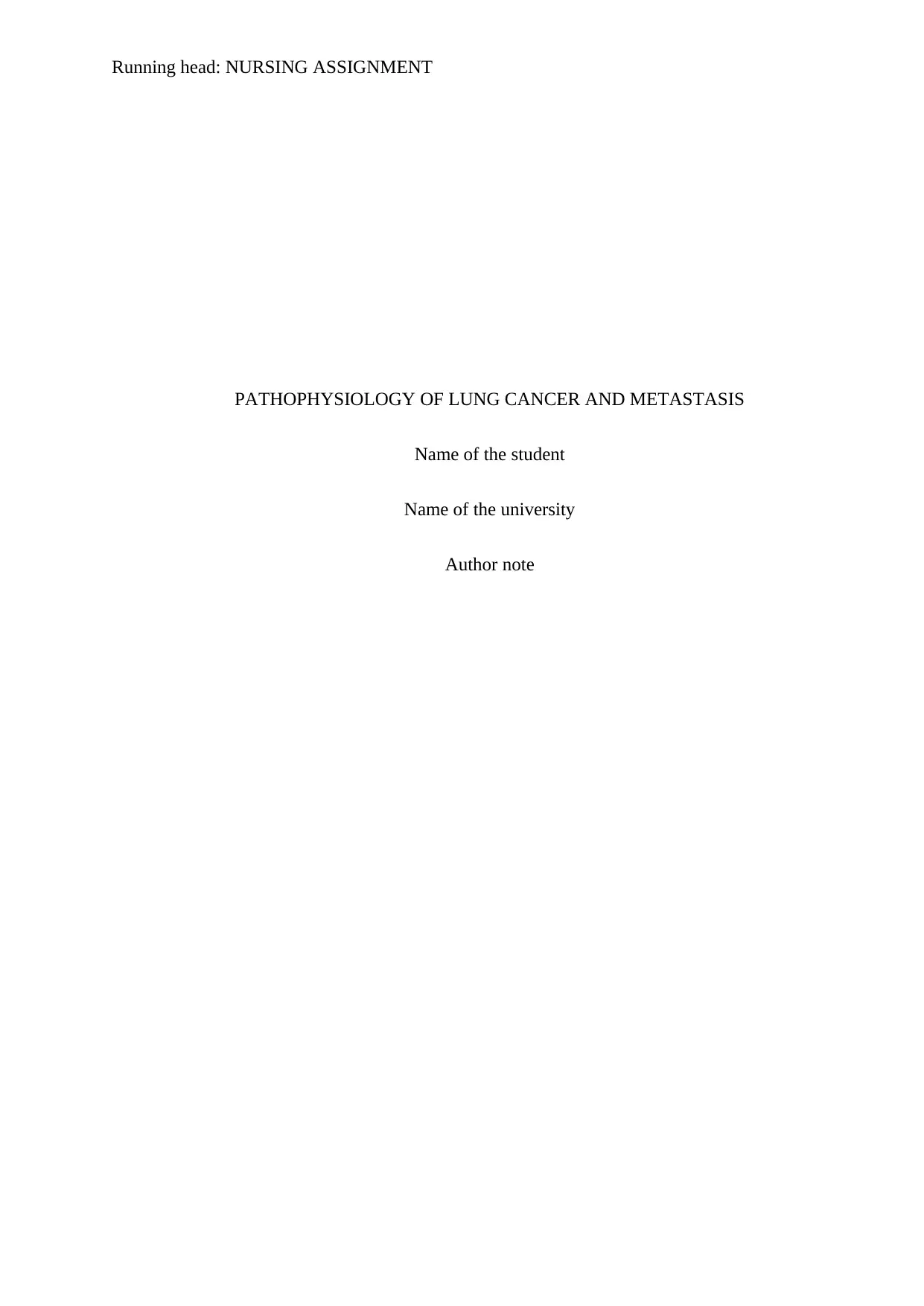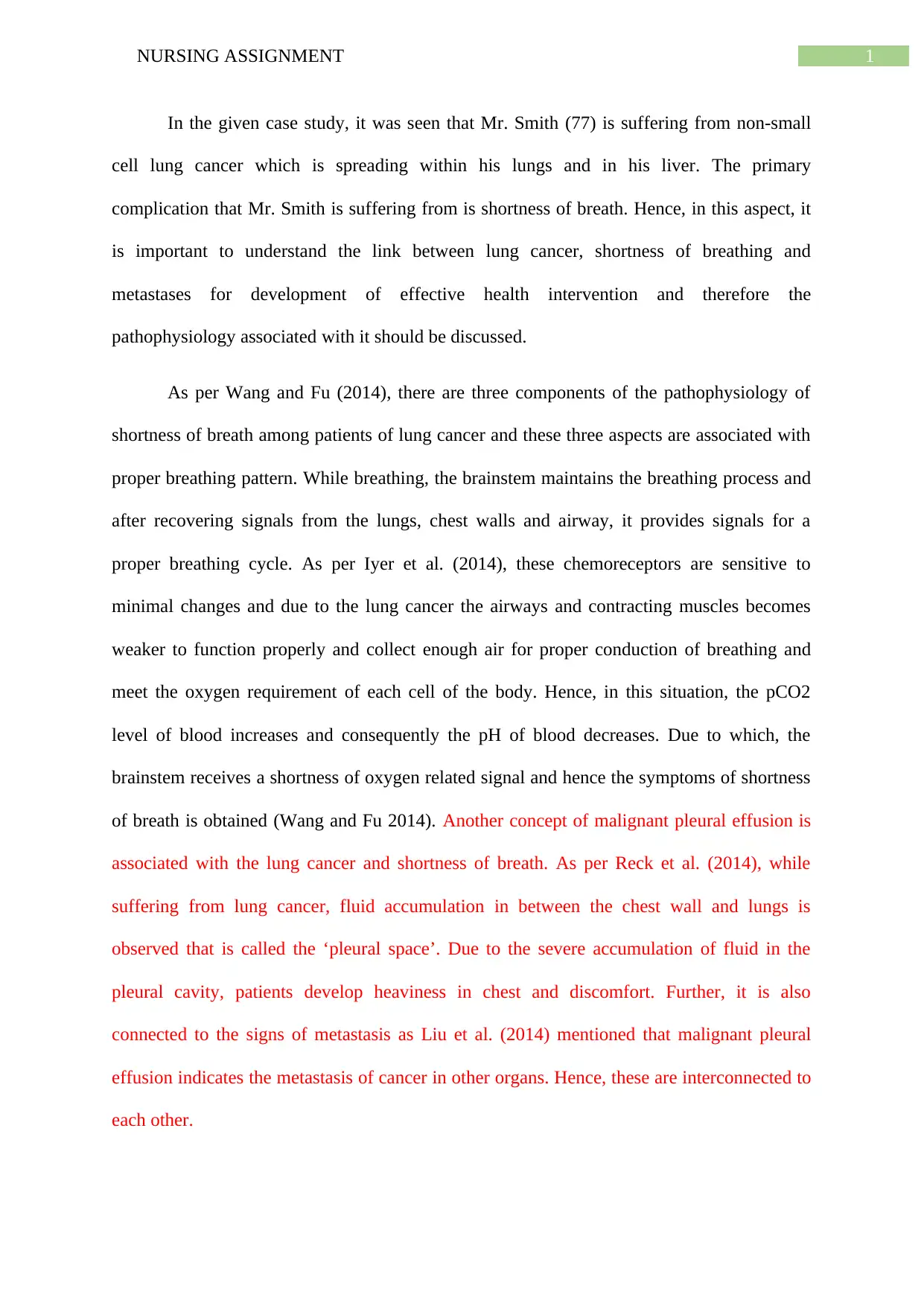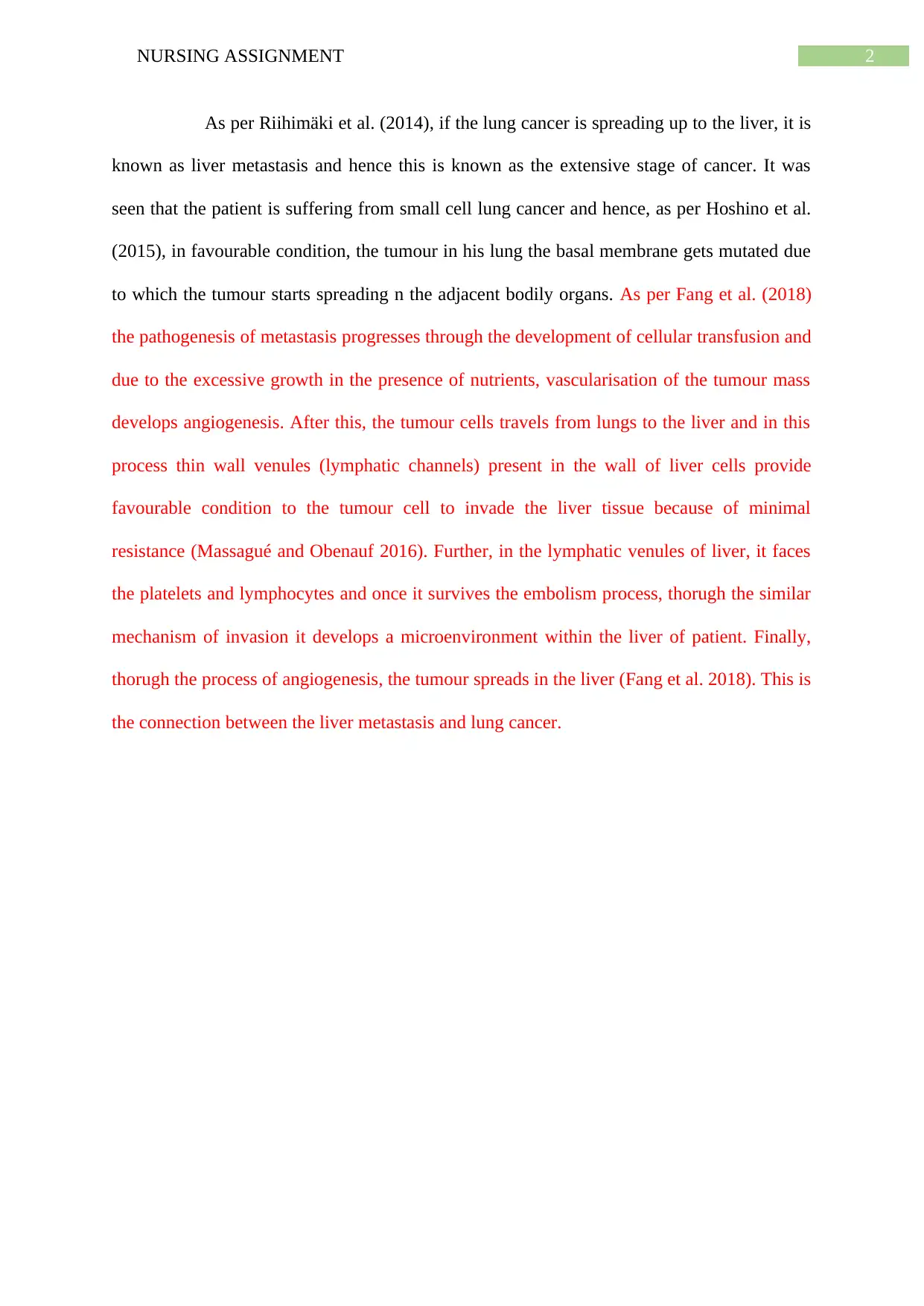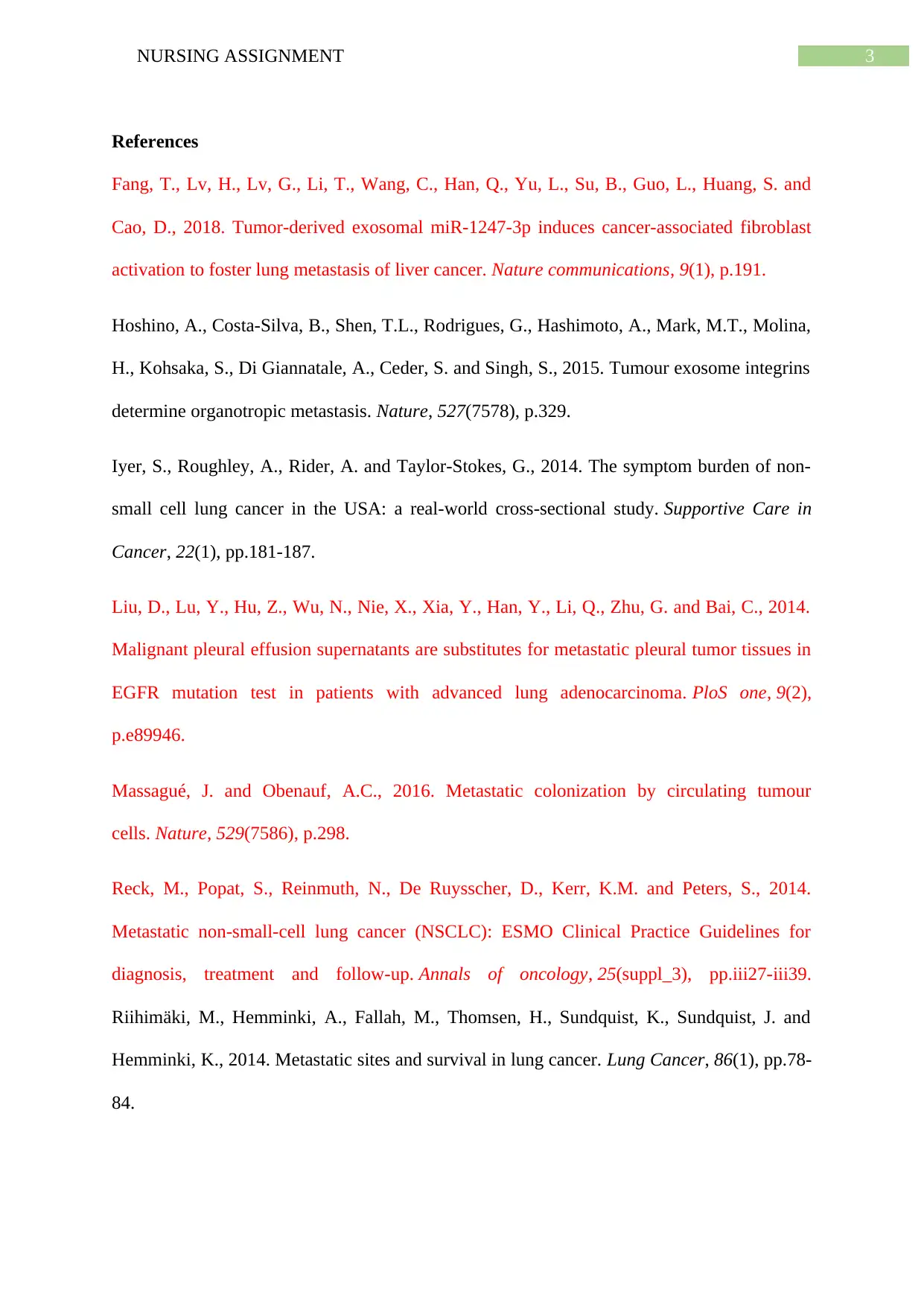Pathophysiology of Lung Cancer and Metastasis: Nursing Assignment
VerifiedAdded on 2023/03/20
|5
|1087
|35
Report
AI Summary
This nursing assignment examines the pathophysiology of non-small cell lung cancer, focusing on a 77-year-old patient, Mr. Smith, experiencing shortness of breath and liver metastasis. The report explores the connection between lung cancer and shortness of breath, detailing the role of the brainstem, chemoreceptors, and changes in blood pCO2 and pH. It also discusses malignant pleural effusion and its relation to metastasis. Furthermore, the assignment explains the process of liver metastasis, including tumor cell mutation, angiogenesis, and the invasion of liver tissue through lymphatic channels. The report references several studies to support its analysis, providing a comprehensive understanding of the disease progression and its implications.

Running head: NURSING ASSIGNMENT
PATHOPHYSIOLOGY OF LUNG CANCER AND METASTASIS
Name of the student
Name of the university
Author note
PATHOPHYSIOLOGY OF LUNG CANCER AND METASTASIS
Name of the student
Name of the university
Author note
Paraphrase This Document
Need a fresh take? Get an instant paraphrase of this document with our AI Paraphraser

1NURSING ASSIGNMENT
In the given case study, it was seen that Mr. Smith (77) is suffering from non-small
cell lung cancer which is spreading within his lungs and in his liver. The primary
complication that Mr. Smith is suffering from is shortness of breath. Hence, in this aspect, it
is important to understand the link between lung cancer, shortness of breathing and
metastases for development of effective health intervention and therefore the
pathophysiology associated with it should be discussed.
As per Wang and Fu (2014), there are three components of the pathophysiology of
shortness of breath among patients of lung cancer and these three aspects are associated with
proper breathing pattern. While breathing, the brainstem maintains the breathing process and
after recovering signals from the lungs, chest walls and airway, it provides signals for a
proper breathing cycle. As per Iyer et al. (2014), these chemoreceptors are sensitive to
minimal changes and due to the lung cancer the airways and contracting muscles becomes
weaker to function properly and collect enough air for proper conduction of breathing and
meet the oxygen requirement of each cell of the body. Hence, in this situation, the pCO2
level of blood increases and consequently the pH of blood decreases. Due to which, the
brainstem receives a shortness of oxygen related signal and hence the symptoms of shortness
of breath is obtained (Wang and Fu 2014). Another concept of malignant pleural effusion is
associated with the lung cancer and shortness of breath. As per Reck et al. (2014), while
suffering from lung cancer, fluid accumulation in between the chest wall and lungs is
observed that is called the ‘pleural space’. Due to the severe accumulation of fluid in the
pleural cavity, patients develop heaviness in chest and discomfort. Further, it is also
connected to the signs of metastasis as Liu et al. (2014) mentioned that malignant pleural
effusion indicates the metastasis of cancer in other organs. Hence, these are interconnected to
each other.
In the given case study, it was seen that Mr. Smith (77) is suffering from non-small
cell lung cancer which is spreading within his lungs and in his liver. The primary
complication that Mr. Smith is suffering from is shortness of breath. Hence, in this aspect, it
is important to understand the link between lung cancer, shortness of breathing and
metastases for development of effective health intervention and therefore the
pathophysiology associated with it should be discussed.
As per Wang and Fu (2014), there are three components of the pathophysiology of
shortness of breath among patients of lung cancer and these three aspects are associated with
proper breathing pattern. While breathing, the brainstem maintains the breathing process and
after recovering signals from the lungs, chest walls and airway, it provides signals for a
proper breathing cycle. As per Iyer et al. (2014), these chemoreceptors are sensitive to
minimal changes and due to the lung cancer the airways and contracting muscles becomes
weaker to function properly and collect enough air for proper conduction of breathing and
meet the oxygen requirement of each cell of the body. Hence, in this situation, the pCO2
level of blood increases and consequently the pH of blood decreases. Due to which, the
brainstem receives a shortness of oxygen related signal and hence the symptoms of shortness
of breath is obtained (Wang and Fu 2014). Another concept of malignant pleural effusion is
associated with the lung cancer and shortness of breath. As per Reck et al. (2014), while
suffering from lung cancer, fluid accumulation in between the chest wall and lungs is
observed that is called the ‘pleural space’. Due to the severe accumulation of fluid in the
pleural cavity, patients develop heaviness in chest and discomfort. Further, it is also
connected to the signs of metastasis as Liu et al. (2014) mentioned that malignant pleural
effusion indicates the metastasis of cancer in other organs. Hence, these are interconnected to
each other.

2NURSING ASSIGNMENT
As per Riihimäki et al. (2014), if the lung cancer is spreading up to the liver, it is
known as liver metastasis and hence this is known as the extensive stage of cancer. It was
seen that the patient is suffering from small cell lung cancer and hence, as per Hoshino et al.
(2015), in favourable condition, the tumour in his lung the basal membrane gets mutated due
to which the tumour starts spreading n the adjacent bodily organs. As per Fang et al. (2018)
the pathogenesis of metastasis progresses through the development of cellular transfusion and
due to the excessive growth in the presence of nutrients, vascularisation of the tumour mass
develops angiogenesis. After this, the tumour cells travels from lungs to the liver and in this
process thin wall venules (lymphatic channels) present in the wall of liver cells provide
favourable condition to the tumour cell to invade the liver tissue because of minimal
resistance (Massagué and Obenauf 2016). Further, in the lymphatic venules of liver, it faces
the platelets and lymphocytes and once it survives the embolism process, thorugh the similar
mechanism of invasion it develops a microenvironment within the liver of patient. Finally,
thorugh the process of angiogenesis, the tumour spreads in the liver (Fang et al. 2018). This is
the connection between the liver metastasis and lung cancer.
As per Riihimäki et al. (2014), if the lung cancer is spreading up to the liver, it is
known as liver metastasis and hence this is known as the extensive stage of cancer. It was
seen that the patient is suffering from small cell lung cancer and hence, as per Hoshino et al.
(2015), in favourable condition, the tumour in his lung the basal membrane gets mutated due
to which the tumour starts spreading n the adjacent bodily organs. As per Fang et al. (2018)
the pathogenesis of metastasis progresses through the development of cellular transfusion and
due to the excessive growth in the presence of nutrients, vascularisation of the tumour mass
develops angiogenesis. After this, the tumour cells travels from lungs to the liver and in this
process thin wall venules (lymphatic channels) present in the wall of liver cells provide
favourable condition to the tumour cell to invade the liver tissue because of minimal
resistance (Massagué and Obenauf 2016). Further, in the lymphatic venules of liver, it faces
the platelets and lymphocytes and once it survives the embolism process, thorugh the similar
mechanism of invasion it develops a microenvironment within the liver of patient. Finally,
thorugh the process of angiogenesis, the tumour spreads in the liver (Fang et al. 2018). This is
the connection between the liver metastasis and lung cancer.
⊘ This is a preview!⊘
Do you want full access?
Subscribe today to unlock all pages.

Trusted by 1+ million students worldwide

3NURSING ASSIGNMENT
References
Fang, T., Lv, H., Lv, G., Li, T., Wang, C., Han, Q., Yu, L., Su, B., Guo, L., Huang, S. and
Cao, D., 2018. Tumor-derived exosomal miR-1247-3p induces cancer-associated fibroblast
activation to foster lung metastasis of liver cancer. Nature communications, 9(1), p.191.
Hoshino, A., Costa-Silva, B., Shen, T.L., Rodrigues, G., Hashimoto, A., Mark, M.T., Molina,
H., Kohsaka, S., Di Giannatale, A., Ceder, S. and Singh, S., 2015. Tumour exosome integrins
determine organotropic metastasis. Nature, 527(7578), p.329.
Iyer, S., Roughley, A., Rider, A. and Taylor-Stokes, G., 2014. The symptom burden of non-
small cell lung cancer in the USA: a real-world cross-sectional study. Supportive Care in
Cancer, 22(1), pp.181-187.
Liu, D., Lu, Y., Hu, Z., Wu, N., Nie, X., Xia, Y., Han, Y., Li, Q., Zhu, G. and Bai, C., 2014.
Malignant pleural effusion supernatants are substitutes for metastatic pleural tumor tissues in
EGFR mutation test in patients with advanced lung adenocarcinoma. PloS one, 9(2),
p.e89946.
Massagué, J. and Obenauf, A.C., 2016. Metastatic colonization by circulating tumour
cells. Nature, 529(7586), p.298.
Reck, M., Popat, S., Reinmuth, N., De Ruysscher, D., Kerr, K.M. and Peters, S., 2014.
Metastatic non-small-cell lung cancer (NSCLC): ESMO Clinical Practice Guidelines for
diagnosis, treatment and follow-up. Annals of oncology, 25(suppl_3), pp.iii27-iii39.
Riihimäki, M., Hemminki, A., Fallah, M., Thomsen, H., Sundquist, K., Sundquist, J. and
Hemminki, K., 2014. Metastatic sites and survival in lung cancer. Lung Cancer, 86(1), pp.78-
84.
References
Fang, T., Lv, H., Lv, G., Li, T., Wang, C., Han, Q., Yu, L., Su, B., Guo, L., Huang, S. and
Cao, D., 2018. Tumor-derived exosomal miR-1247-3p induces cancer-associated fibroblast
activation to foster lung metastasis of liver cancer. Nature communications, 9(1), p.191.
Hoshino, A., Costa-Silva, B., Shen, T.L., Rodrigues, G., Hashimoto, A., Mark, M.T., Molina,
H., Kohsaka, S., Di Giannatale, A., Ceder, S. and Singh, S., 2015. Tumour exosome integrins
determine organotropic metastasis. Nature, 527(7578), p.329.
Iyer, S., Roughley, A., Rider, A. and Taylor-Stokes, G., 2014. The symptom burden of non-
small cell lung cancer in the USA: a real-world cross-sectional study. Supportive Care in
Cancer, 22(1), pp.181-187.
Liu, D., Lu, Y., Hu, Z., Wu, N., Nie, X., Xia, Y., Han, Y., Li, Q., Zhu, G. and Bai, C., 2014.
Malignant pleural effusion supernatants are substitutes for metastatic pleural tumor tissues in
EGFR mutation test in patients with advanced lung adenocarcinoma. PloS one, 9(2),
p.e89946.
Massagué, J. and Obenauf, A.C., 2016. Metastatic colonization by circulating tumour
cells. Nature, 529(7586), p.298.
Reck, M., Popat, S., Reinmuth, N., De Ruysscher, D., Kerr, K.M. and Peters, S., 2014.
Metastatic non-small-cell lung cancer (NSCLC): ESMO Clinical Practice Guidelines for
diagnosis, treatment and follow-up. Annals of oncology, 25(suppl_3), pp.iii27-iii39.
Riihimäki, M., Hemminki, A., Fallah, M., Thomsen, H., Sundquist, K., Sundquist, J. and
Hemminki, K., 2014. Metastatic sites and survival in lung cancer. Lung Cancer, 86(1), pp.78-
84.
Paraphrase This Document
Need a fresh take? Get an instant paraphrase of this document with our AI Paraphraser

4NURSING ASSIGNMENT
Wang, D. and Fu, J., 2014. Symptom clusters and quality of life in China patients with lung
cancer undergoing chemotherapy. African health sciences, 14(1), pp.49-55.
Wang, D. and Fu, J., 2014. Symptom clusters and quality of life in China patients with lung
cancer undergoing chemotherapy. African health sciences, 14(1), pp.49-55.
1 out of 5
Related Documents
Your All-in-One AI-Powered Toolkit for Academic Success.
+13062052269
info@desklib.com
Available 24*7 on WhatsApp / Email
![[object Object]](/_next/static/media/star-bottom.7253800d.svg)
Unlock your academic potential
Copyright © 2020–2025 A2Z Services. All Rights Reserved. Developed and managed by ZUCOL.




